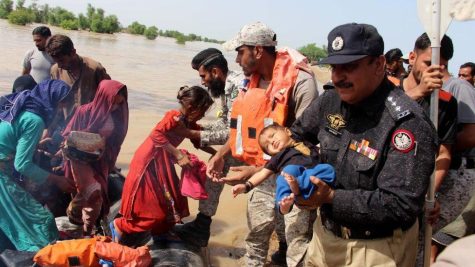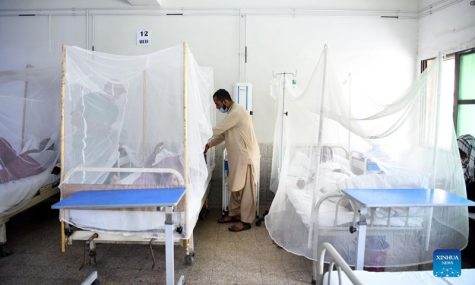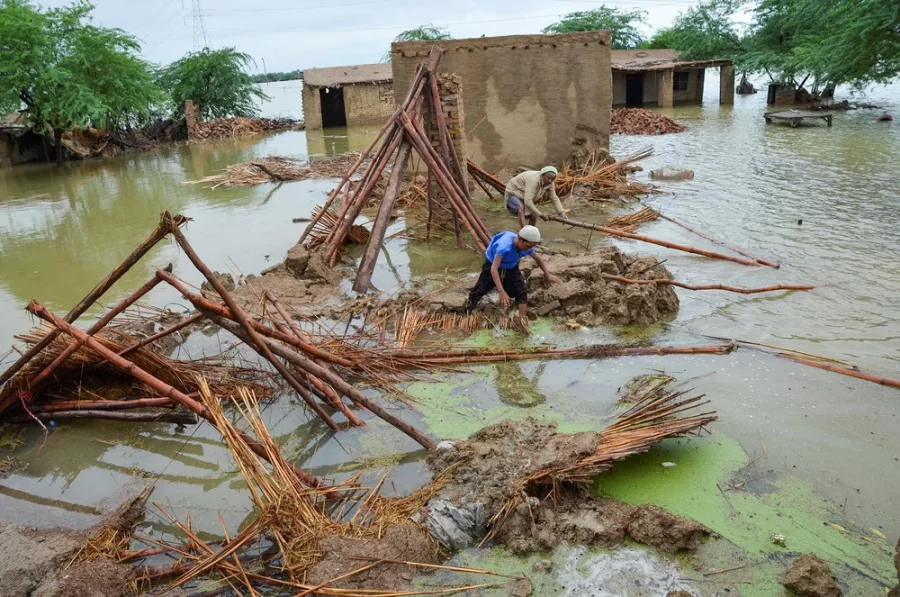A Disaster of Biblical Proportions: Pakistan Faces Massive Flooding Across the Country
A general overview of the situation in Pakistan as of September 20, 2022
Survivors of the floods retrieve bamboo poles from the water in an attempt to rebuild in the Balochistan Province. Many blame the extent of the devastation on shoddy building requirements and government ineptitude. 8/25/22 Credit: Amer Hussain/Reuters
September 21, 2022
Ever since June, Pakistan has been bombarded with what United Nations secretary general Antonio Guterres calls a “monsoon season on steroids” coupled with melting glaciers in the northern regions, both of which have created massive flooding that has caused at least a third of the country to be submerged underwater.
This comes directly after a heatwave that lasted from April into the summer months, with temperatures climbing into the triple digits. “These were not normal heatwaves,” Pakistan’s former minister of climate change Malik Amin Aslam stated, “they were the worst in the world.”
Connected, both disasters have wreaked havoc on both the people and infrastructure of the South Asian country, as over 33 million people, one in seven Pakistanis according to The New Humanitarian organization, have been affected by the floods and at least 1,400 people have died as a result. Additionally, the effects of the flooding and heatwave that preceded it have devastated the country’s ability to respond to the crisis.

According to statistics put out by the Pakistani government alongside the U.N. on August 30, at least 325,000 houses have been destroyed with twice that number damaged by the floods, 735,000 livestock have been lost, and over 2 million acres of crops have been damaged, destroying crop harvests across the country.

Much of the damage was due to ongoing political instability and ineptitude in the country. Due to a lack of managing building regulations, poor construction has greatly increased the damage to infrastructure. Maryam Jamali, a 19 year old living in the Balochistan province, has seen her entire village swept away, which she blames on shoddy infrastructure.
“Some of these [irrigation] canals aren’t even properly built yet, but water is being released into them and they are breaking left and right.” -Maryam Jamali
Additionally, at least 12 dams have broken over the course of the tumultuous summer, though those in authority have brushed off any blame. Even though many see the catastrophic failure of the dams to hold back the flood as signs of corruption, the provincial government of Balochistan claims that the damage was due to the massive influx of water. The government also promised that repair work on the dams would be “expedited”, according to the news outlet Dawn. In all, at least $30 billion have been lost in the damages caused by the floods, triple the previously estimated costs of $10 billion.
The damages aren’t only limited to the economic sphere, however. Amidst the flooding of cities, crumbling infrastructure, and general chaos, waterborne infections have become widespread across affected areas in what the World Health Organization has deemed a “second disaster”. As the drinking water becomes contaminated by the various debris, people are forced to drink it to survive, causing cholera to spread rapidly.
Additionally, other outbreaks of diseases and viruses such as dengue fever, malaria, polio (as Pakistan is one of two polio-endemic countries in the world, joined by its western neighbor Afghanistan), and COVID-19 are being exacerbated by the circumstances, according to the UN. WHO, in tandem with the local authorities, are working to ensure “rapid access to essential health services…and expand disease surveillance, outbreak prevention and control”, as per the WHO representative for Pakistan, Dr. Palitha Mahipala.

Health centers have been hit particularly hard, and as of September 18 there have been 2,000 which have been “fully or partially damaged”, according to WHO Director General Tedros Ghebreyesus. “Health centers have been flooded, their supplies damaged, and people have moved away from home which makes it harder for them to access their normal health services,” said Ghebreyesus in an official statement. The need for efficient and rapid health centers are increasing, as shown in the Sindh province, one of the hardest hit. From July to the current date, at least 2.5 million people have been treated at the various camps across the province, and at least 90,000 are treated daily.
The need for a quick response to the absolute catastrophe in Pakistan has been answered by most of the world, yet its effects will continue to linger on. With as much damage that has been done to vital infrastructure, the economy, and to the population, aid and resources will have to be supplied and processes will have to be reformed to ensure that such a disaster will never happen again on this scale.




















